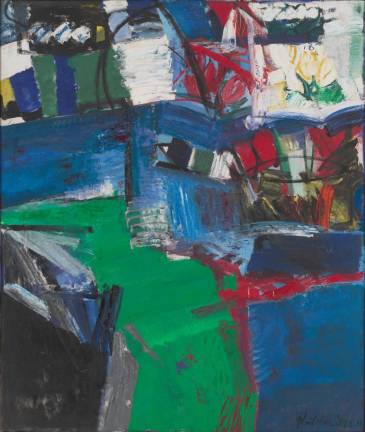Grace Hartigan’s ‘Shinnecock Canal’
Meet a MoMA masterpiece

Art is long, Hippocrates wrote in the 4th century BC. The fact that we know he said this proves his point. But lots of people said lots of things we don’t remember, which proves the premise. It’s art – with its breakthroughs and resonances, allusions and revelations – that has staying power, but only if and because it speaks to us. Grace Hartigan’s painting “Shinnecock Canal” at the Museum of Modern Art spoke to me years ago, and it still does. Correction: it calls to me, sings to me, shouts and hollers.
The painting, an Abstract Expressionist masterpiece from 1957, is seven and a half feet tall and over six feet wide. It’s more portal than picture and draws you in from across a room. A great grass-green swath leads from the bottom of the picture inward. It’s edged in ocean blue, black and white. Dashes of red, black and yellow form uncertain shapes (A bridge? Boats? Traffic lights? Advertising on a harborside building?) The primary colors keep your eye climbing, progressing, making side trips and returning. There’s an oceanic, churning energy, composed of and punctuated by swirling lines and raking drags of paint across the surface.
Shinnecock Canal pierces Long Island on its eastern, southern shore. It’s culturally and spatially the dividing line between “The Hamptons” and the rest of the world – both a passage and a rite of passage. Hartigan, with artist friends like Jackson Pollock and Lee Krasner, Willem and Elaine de Kooning, Helen Frankenthaler and Robert Motherwell, as well as the poet Frank O’Hara (with whom she collaborated) spent time on Long Island, away from her New York apartment.
Due to the size of the work, when standing close, the painting fills the viewer’s field of vision. It appears to extend beyond the edges of space, engulfing you; expansiveness is a hallmark of Abstract Expressionist works. Surrounded by its colors and shapes, you can easily imagine the sound of crashing waves, the tang of salt air, the beating sun that cranks up the intensity of tones. It’s all there. But in reality, it isn’t. In reality, it’s paint.
“George Hartigan”
Hartigan had unique success as a woman artist in the 1950s. Her life was complicated, peripatetic and stressful. She grew up in New Jersey, married young, had a child in her teens, crossed the country in hopes of an idyllic life on the Alaskan frontier, ran out of money, broke up with her husband, asked her in-laws to raise her only child, and returned to New York to study art – not for art’s sake, but to earn a living.
For a time, she exhibited under the name “George Hartigan,” both as a sign of solidarity with George Sand and George Eliot (two 19th century women writers who used male pen names) and to overcome the prejudice against women artists. Still, in 1953, she was the first woman from what’s come to be known as the New York School of painters to have a work acquired by the Museum of Modern Art, and the only woman to be included in its landmark 1958 traveling exhibition “The New American Painting” that introduced American Modernism to European audiences. Life Magazine, in 1957, referred to Hartigan as “the most celebrated of the young American women painters.”
But these things don’t make her art speak. That comes from her ideas and emotions, her way of seeing and showing. Hartigan was rare among Abstract painters in that she brought bits of reality to her paintings. “I just had to throw in something of the life around me, even if it was just fragments, little memories, little snatches, little wisps of a corner, a piece of fruit, a vendor going by, something,” she said. It drew the ire of some critics and the praise of others who saw it as a way to transcend being locked into a movement after time had moved on. Semi-referential, semi-abstract compositions like Hartigan’s make her work more accessible for many.
“Shinnecock Canal” may not look like a landscape, but it feels like one. Its energy comes from her response to the world around her as she monumentalizes a mere patch of lawn. Her bold, gutsy brushstrokes and punches of color aren’t just about the landscape, though. They’re about seeing the world anew.
Our universe has gotten smaller in many ways this year. We may not be able to go everywhere we want, and there are very real restrictions. But smaller doesn’t need to mean less. Marcel Proust is often quoted as having said, “The real voyage of discovery consists not in seeking new landscapes, but in having new eyes.” Great beauty and emotionally rewarding vistas can be found puddles, in a patch of sky, orange carrots on a plate, the moon at night, a potted plant.
But it’s not only in nature that we find inspiration (though Hartigan admitted it made her giddy). We go to museums to see beloved works and make discoveries. “Shinnecock Canal” may not be as famous as pilgrimage-engendering Pollocks and de Koonings at MoMA, but to my eyes, it’s just as much a masterpiece. When you get to it, decide for yourself, and til then, look around at your own world with new eyes.